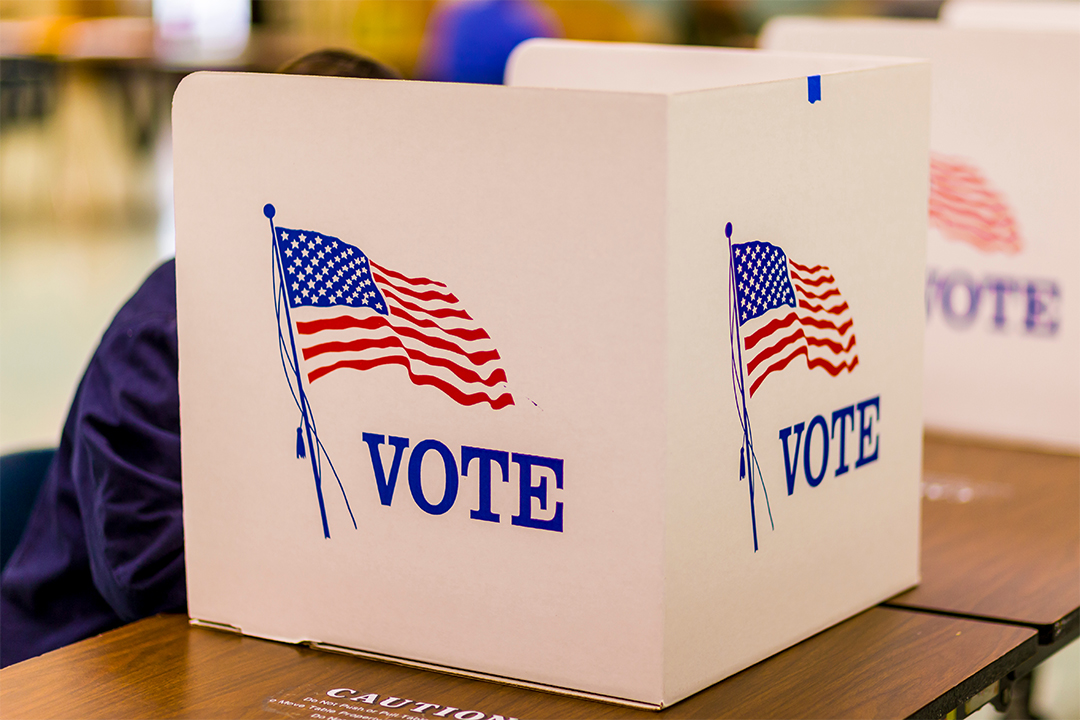On a recent Montgomery County election day, Professor of Mathematics Daniel Ullman found himself befuddled in a voting booth. There were six candidates on his ballot: five who all favored similar positions and one who was decidedly less mainstream.
Ullman’s conundrum wasn’t political. It was mathematical. Poised over his ballot, he realized the calculations were off. He could only vote for a single candidate. The five similar ones might, in theory, split the vote. The outlier sixth candidate could play the role of spoiler, leap-frogging to victory despite holding views that most of the county’s voters rejected.
With voters restricted to just one choice in a crowded field, the spoiler candidate “could win even though he’s the least popular,” Ullman explained. From a mathematical standpoint, he reasoned, there had to be a better way.
Ranked voting? Point systems? Thumbs-up/thumbs-down? When it comes to examining electoral alternatives, Ullman wrote the book—literally. Along with Professor of Mathematics E. Arthur Robinson, he co-authored The Mathematics of Politics, a seminal text on the role math plays in our political system. Ullman also teaches the undergraduate course Mathematics and Politics. (Robinson taught it in past semesters.) And as the midterms approach, the expert pair have looked at elections through the lens of mathematical theorems, proofs and equations.
Their conclusion? When you do the math, our voting systems don’t add up.
Bad and Worse
Most Americans elections for state and federal offices follow two formats: The majority use a basic plurality—voters choose one candidate and whomever receives the most votes win. The presidential race, however, is decided by the complicated Electoral College system. Ullman and Robinson say both methods are fatally flawed—to the point where a 2010 Swiss survey of political scientists ranked plurality last among preferred methods. The Electoral College didn’t even make the list.
Plurality is fine for choosing between two candidates, Ullman and Robinson explain. But it flops in a larger field. It doesn’t let voters express their preference for more than one candidate. And it can lead to a third party hijacking a crowded race. Take, for example, the disputed 2000 presidential election. In the all-important Florida contest, George W. Bush defeated Al Gore by just 537 votes. Left-leaning third party candidate Ralph Nader received 97,000 votes. Assuming Nader voters preferred Gore to Bush, Ullman and Robinson say it’s mathematically reasonable to conclude that Nader spoiled Gore’s chances of victory. “If we weren’t stuck on plurality, if voters could express preferences for several candidates rather than picking just one, the numbers would have looked very different,” Ullman said.
If plurality is broken, the Electoral College is beyond repair, they said. “Plurality voting may be a mediocre way to conduct elections, but it's certainly better than the really bad Electoral College,” Ullman said.
In addition to the real possibility that a president can be elected with a minority of the popular vote—it’s happened four times, most recently in 2016—the winner-take-all Electoral College doesn’t weigh each vote equally. Some votes count more than others. Again, in 2000, Gore carried California handily but lost Wyoming by a narrow margin. A Gore vote in Wyoming had a greater impact on the election than one in California. “Had Al Gore picked up 100 percent of the California vote, he would have been the top choice of a vast majority of the national electorate—and still lost,” Ullman said.
Left to right, Professors of Mathematics E. Arthur Robinson and Daniel Ullman. (Photo: William Atkins)
A Better Way?
So is there a better way to count votes? It’s a question Ullman and Robinson hear from their students—and their answer is rarely satisfying. According to a mathematical concept called Arrow’s Theorem, no voting system can fulfill all fairness criteria all the time. In other words, “the Theorem of Arrows says you can’t have everything,” Robinson explained.
But elections must go on. And the professors point to the Swiss’ polls first choice: approval voting. It allows voters to check off as many candidates as they like. “You essentially vote yes or no, thumbs up or thumbs down, for all the candidates on a ballot,” Ullman said. Frequently used to elect boards of trustees and even the secretary general of the United Nations, approval voting favors consensus candidates and all but eliminates a Nader-like spoiler effect. It also solves Ullman’s Montgomery County ballot dilemma. He could “approve” five candidates and cast a thumbs down for the sixth.
But approval voting isn’t perfect either. Voters can’t indicate a strong preference for their top candidate. All the thumbs-up are given equal weight—which can actually hurt the odds of your first choice winning.
Ranked-choice voting, which is second on the Swiss survey, lets voters show a clear favorite by listing each candidate in their preferred order: first, second, third, etc. In a version called the Hare Method, the candidate with the fewest first-place votes is eliminated—second, third and subsequent choices move up until someone receives a majority. A twist on Hare is the Borda Count, which is essentially a point system. Voters still rank each candidate, but they are then assigned point values; one point for last, two for next-to-last and so on. The person with the most points wins.
Both Hare and Borda have been used to determine real-world elections. (Hare in Australia, Ireland and Malta; Borda in Slovenia and Iceland.) Proponents say ranked-choice tends to elect broadly acceptable candidates. It can also result in a winner emerging without the most first-place votes.
Neither Ullman nor Robinson expects a major shift in America’s national election formats. But local election landscapes frequently experiment with novel voting methods. Municipal contests from Takoma Park to San Francisco use the Hare Method. And this year, Maine became the first state to adopt ranked-choice voting for congressional primaries. Robinson even persuaded a student to use a Borda Count for her sorority elections. It may not be the Electoral College, he joked, but it’s a start.



